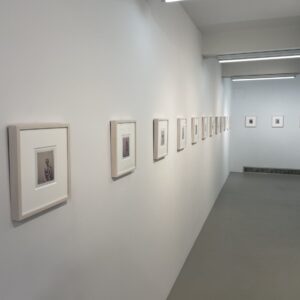JTF (just the facts): Published in 2024 by Photobook Daydream Editions (Instagram link here). Softcover (29.7 x 21 cm), 60 pages, with 52 color photographs. There are no essays or texts included. In an edition of 22 copies. (Cover and spread shots below.)
Comments/Context: Photobook Daydream Editions is a new publishing initiative started by the Los Angeles-based photographer and photobook collector Andrew Seitz, and its intention is to highlight and share the work of emerging artists by publishing zines. Seitz says he was always drawn to the process of editing photographs, and credits a series of zines by photographer Ayana Fujibayashi and the works of FancyshopDrivein (a Japanese website that sells photobooks and zines and also focuses on the creative process) as two key influences in starting his own publishing effort. He approaches publishing as a collaborative process, often discussing different inspirations (like music, fonts, favorite photobooks, etc) with the artists, which are then embedded in the final projects as hidden references.
The first zine released by Photobook Daydream Editions, titled They Swallow, featured the work of Japanese photographer Satoh Kakeru, and the second features another Japanese artist Tetsuta Tsurumoto. The title of the Tsurumoto zine – 「ウ」「ォ」「ー」- is three symbols converted into sounds, the closest English equivalent being「W」「O」「R」. Tsurumoto says that through the act of photography, he explores the distance from words.
「ウ」「ォ」「ー」is a horizontally-oriented publication with a spiral binding. Bluish photographs of a wolf or a dog reflected off a surface (maybe a TV screen) take up the entire front cover, serving as an intriguing introduction. Inside, color photographs appear on every page, with a thin white border around them. In a way, every bit of available space in the book is used to show photographs. The title of the zine (in Japanese) is placed on the opening end papers, repeated in multiple rows taking over the entire spread. In a similar way, the name of the artist appears a couple of pages later, followed by the publisher name and the year of the publication at the very end. There are no other captions, page numbers, or any other texts.
Most of Tsurumoto’s photographs are shot outside, and while there are no obvious indications of location, it is clear they were shot in Japan. The visual flow doesn’t follow any linear narrative or common subject matter. Tsurumoto sees photography as a way to play, and tries to find “play” in the gap between the world of meaning and the world of meaninglessness. We can immediately notice his interest in reflective surfaces, light, and distortion, and his enigmatic style seems to be driven more by aesthetics than by the desire to communicate any one thing in particular.
Tsurumoto’s photographs capture the chaos of wiring, reflective surfaces of buildings, close ups of signs, construction areas, etc. In one image, he points his flashing camera in a mirror, placing himself right in the center of the image, and to the left there is an inside space while to the right is outside. The photograph on the right side of the same spread captures what looks like a construction site with a fence, wires, blue tarps, and orange cones. Throughout the zine, Tsurumoto actively plays with reflections, fragmentations, and illusions.
The series of photographs in the zine looks naturally out of the ordinary, captured in a playful and straightforward manner. Tsurumoto is drawn to rather banal moments and observations of everyday urban life seen in a pure and untainted manner, but he finds something curious in almost any given situation. A shot of a playground brings our attention to its geometrical elements (tubes, poles, circles, etc) in bright blue, yellow, and red colors, and this picture is placed next to a very different shot of a escalator with a red wall on one side and semi circular shaped window on the other, drawing parallels between the two photos. In another photograph, a long tale of a giant reptile maquette runs diagonally cutting the image into two parts, and on the opposite side an old pipe stretches on the ground, also reminiscent of a snake. Formal echoes make these two at first unrelated shots mirror each other.
The images flow in accumulating effect, with individual shots surrendering to the needs of the sequencing, creating a sense of a whole. The zine is an unpretentious self-contained publication, enlivened by thoughtful sequencing and editing, and its content is well matched to the zine format. More broadly, it’s exciting to see passionate collectors take on (and support) publishing efforts, so it will be intriguing to follow this initiative as Photobook Daydream Editions finds its way forward.
Collector’s POV: Tetsuta Tsurumoto does not appear to have consistent gallery representation at this time. As a result, interested collectors should likely follow up directly with the artist via his Instagram page (linked in the sidebar).





















